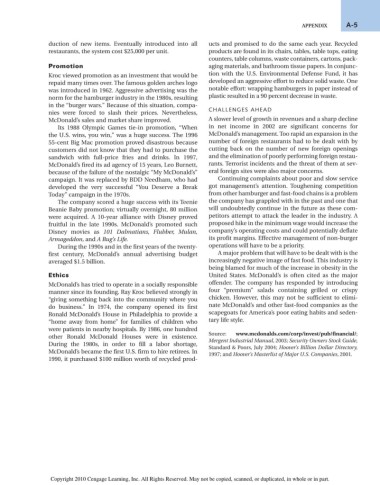Page 671 - Introduction to Business
P. 671
APPENDIX A-5
duction of new items. Eventually introduced into all ucts and promised to do the same each year. Recycled
restaurants, the system cost $25,000 per unit. products are found in its chairs, tables, table tops, eating
counters, table columns, waste containers, cartons, pack-
Promotion aging materials, and bathroom tissue papers. In conjunc-
Kroc viewed promotion as an investment that would be tion with the U.S. Environmental Defense Fund, it has
repaid many times over. The famous golden arches logo developed an aggressive effort to reduce solid waste. One
was introduced in 1962. Aggressive advertising was the notable effort: wrapping hamburgers in paper instead of
norm for the hamburger industry in the 1980s, resulting plastic resulted in a 90 percent decrease in waste.
in the “burger wars.” Because of this situation, compa-
nies were forced to slash their prices. Nevertheless, CHALLENGES AHEAD
McDonald’s sales and market share improved. A slower level of growth in revenues and a sharp decline
Its 1988 Olympic Games tie-in promotion, “When in net income in 2002 are significant concerns for
the U.S. wins, you win,” was a huge success. The 1996 McDonald’s management. Too rapid an expansion in the
55-cent Big Mac promotion proved disastrous because number of foreign restaurants had to be dealt with by
customers did not know that they had to purchase the cutting back on the number of new foreign openings
sandwich with full-price fries and drinks. In 1997, and the elimination of poorly performing foreign restau-
McDonald’s fired its ad agency of 15 years, Leo Burnett, rants. Terrorist incidents and the threat of them at sev-
because of the failure of the nostalgic “My McDonald’s” eral foreign sites were also major concerns.
campaign. It was replaced by BDD Needham, who had Continuing complaints about poor and slow service
developed the very successful “You Deserve a Break got management’s attention. Toughening competition
Today” campaign in the 1970s. from other hamburger and fast-food chains is a problem
The company scored a huge success with its Teenie the company has grappled with in the past and one that
Beanie Baby promotion; virtually overnight, 80 million will undoubtedly continue in the future as these com-
were acquired. A 10-year alliance with Disney proved petitors attempt to attack the leader in the industry. A
fruitful in the late 1990s. McDonald’s promoted such proposed hike in the minimum wage would increase the
Disney movies as 101 Dalmatians, Flubber, Mulan, company’s operating costs and could potentially deflate
Armageddon, and A Bug’s Life. its profit margins. Effective management of non-burger
During the 1990s and in the first years of the twenty- operations will have to be a priority.
first century, McDonald’s annual advertising budget A major problem that will have to be dealt with is the
averaged $1.5 billion. increasingly negative image of fast food. This industry is
being blamed for much of the increase in obesity in the
Ethics United States. McDonald’s is often cited as the major
McDonald’s has tried to operate in a socially responsible offender. The company has responded by introducing
manner since its founding. Ray Kroc believed strongly in four “premium” salads containing grilled or crispy
“giving something back into the community where you chicken. However, this may not be sufficient to elimi-
do business.” In 1974, the company opened its first nate McDonald’s and other fast-food companies as the
Ronald McDonald’s House in Philadelphia to provide a scapegoats for America’s poor eating habits and seden-
“home away from home” for families of children who tary life style.
were patients in nearby hospitals. By 1986, one hundred
other Ronald McDonald Houses were in existence. Source: www.mcdonalds.com/corp/invest/pub/financial/;
Mergent Industrial Manual, 2003; Security Owners Stock Guide,
During the 1980s, in order to fill a labor shortage,
Standard & Poors, July 2004; Hoover’s Billion Dollar Directory,
McDonald’s became the first U.S. firm to hire retirees. In
1997; and Hoover’s Masterlist of Major U.S. Companies, 2001.
1990, it purchased $100 million worth of recycled prod-
Copyright 2010 Cengage Learning, Inc. All Rights Reserved. May not be copied, scanned, or duplicated, in whole or in part.

